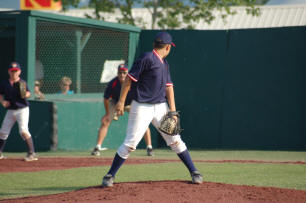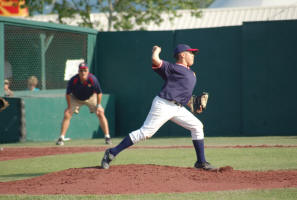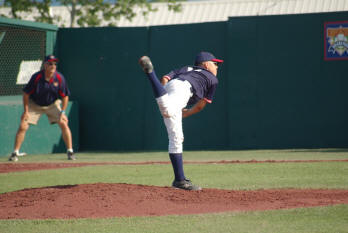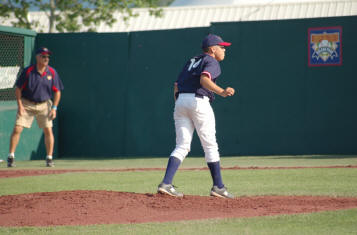
Pitching a baseball is not
what our bodies were built to do. Arm injuries due to pitching can be prevented
if you if use these 3 keys.
Proper warm-up
Correct mechanics
Sufficient Rest
 Parents, coach's and players should be aware that every ball player especially
youth pitchers should warm up properly before they pick up a ball to throw or
pitch. Parents, coach's and players should be aware that every ball player especially
youth pitchers should warm up properly before they pick up a ball to throw or
pitch.
If you take the time to warm up before pitching.... you can avoid many future
arm injuries. Use some stretching exercises to get loose, followed by running 2
sets of poles... (A set of poles consists of running from one foul pole along
the home run fence to the other foul pole and back again.)
After you've jogged and stretched, all players should do arm circles.
Arm circles are nothing more than holding both arms out to your side and
SLOWLY making circle motions with your arms. Begin with 10 small circles
forward and 10 small circles backwards. Follow this with 10 larger circles
forward followed by 10 backwards. Finally make 10 giant circles forward by 10
backwards. If you do these SLOWLY you will begin to feel a burn in the
shoulders.
As you get stronger you can start adding a ball to each hand. Eventually you
should work up to holding 3 balls in each hand while doing these circles.
 Youth Pitching without proper
mechanics is a recipe for disaster. Youth Pitching without proper
mechanics is a recipe for disaster.
Youth pitching mechanics is
not something you should learn from an internet site. Find a qualified pitching
instructor and have your player properly trained.
Local college's often have baseball camps where pitching is taught. There are
many private pitching coaches today that specialize in youth pitching.
Ask around for recommendations and do your homework before you turn over your
child to the coach. Ask questions about their experience. Ask if they teach the
importance of arm care. Find out if they adhere to a pitch count regiment.
Pay for 1 lesson and see how your player relates to the coach. If your child is
comfortable and you like what you see then and only then consider buying a
package deal of lessons that can save you money.
The best instructors include video tape analysis. Without the aid of video tape
it's difficult for youth pitchers to visualize what part of their mechanics they
need to change.
Video tape allows the player to see what he is doing wrong.
Pitching can obviously be taught without the aid of video. It was taught for
over 100 years before video, but it is easier and more effective with video.

Pitch counts and proper rest must be used in youth pitching to
prevent injuries.
Most youth leagues today have minimum rest periods required between pitching
outings. The problem is they are based on the number of innings thrown as
opposed to the number of pitches thrown.
The best pitchers in the major leagues will throw 10-15 pitches an inning. If
they throw 7 innings that's approximately 70-105 pitches in a game.
Its not uncommon for a youth pitcher (10-12 yrs. old) to throw 30-35 pitches in
an inning, if he is struggling with his control. With a 6 inning limit he has
the potential to throw 120-150 pitches in 1 game. A 10-12 yr. old throwing
120-150 pitches is criminal.
If he struggles for 3 innings he could throw 90 pitches. Many arm injuries are
due to this 1 rule alone. Don't let it happen to your child. Children under 13
have growth plates in their arms that will be damaged if he makes a habit of
throwing too many pitches in a game.
Insist that your pitcher is
monitored by pitch count and not innings.
|